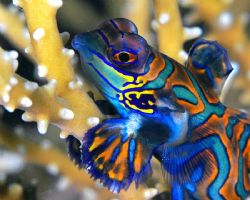Interactions
Mandarinfish are very small reef dwellers that due to the
habitat they live in
are prone to being bottom-feeders. They primarily feed on small
crustaceans and other small invertebrates (Encyolpedia of Life).
Based on research of the gut analysis conducted by Yvonne
Sadovy, the mandarinfish diet includes organisms such as small gastropods,
fish eggs, ostracods (Sadovy et al. 2001). These mandarinfish
feed continuously throughout the day and since they are slowing
moving it is common for them to target prey that are trapped in
the coral in a small range of their home (Encyclopedia of Life).
Since the mandarinfish is mostly a passive fish, it is not known
to be a predator to many organisms. They mainly eat what is found
living in the reefs around them or around other live rock and do not
need to go out an hunt for their food like other organisms
(University of Michigan Museum of Zoology).

Mandarinfish are usually found in groups or pairs in the reef and these fish do not have much interaction with other species. This is due to the fact that they hide within in the crevices of their home range of the coral throughout the day (University of Michigan Museum of Zoology).
Mandarinfish do not have many predators since they secret mucous that can act in repelling predators. In addition, the colors on their skin are bright, which may act as a way of signaling off potential predators (Savdovy et al. 2005). This is because oftentimes brightly colored organisms are a signal of being toxic and these colors are used to warn other organisms to stay away. To learn more about the mucous secreted by the mandarinfish you can visit the form and function page.
There is little known about the role of mandarinfish in the ecosystem since they for the most part keep to themselves in their own comfort zone of their homes within the reefs (Sadovy et al. 2004).
To learn some fun, interesting facts about Synchiropus splendidus, click here!
To return to the home page, click here!